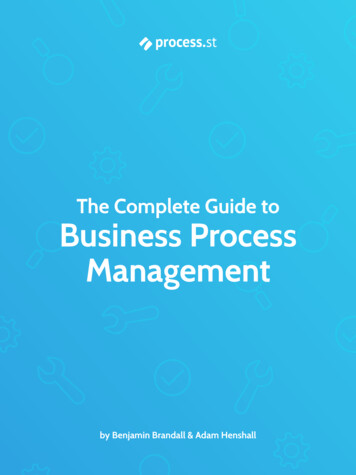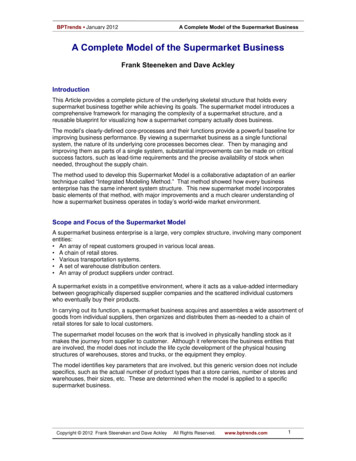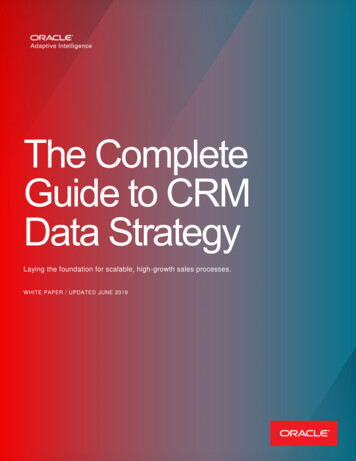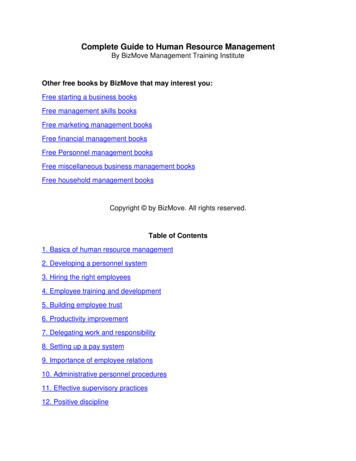
Transcription
The Complete Guide toBusiness ProcessManagementby Benjamin Brandall & Adam Henshall
The Complete Guide to Business Process ManagementIndex01.What is a Process?A Non-Boring Guide for Regular People02.How Processes Protect Your BusinessFrom Crashing and Burning03.Why the Normalization of Devianceis Hurting Your Company04.What is Business Process Management?05.Business Process Analysis06.Why You Should BotherWith Business Process Modeling07.How to Switch to BPM SoftwareWhen You’re Just Using Paper08.Business Process Reengineering09.Is Business Process Outsourcing RelevantFor Your Small Business?–2–
The Complete Guide to Business Process Management01.What is Process?A Non-BoringGuide for RegularPeople
The Complete Guide to Business Process ManagementWhat is a Process?A Non-Boring Guide for Regular PeopleProcesses are a lot more interesting than you’d first think. That isn’tsome kind of joke — they’re interesting, I swear.Although they’re defined as “a collection of interrelated work tasksinitiated in response to an event that achieves a specific result”, there’sa bit of a backstory that helps us cut through the corporate tranquilizersand understand what a process is, and why processes matter.First, a few examples of processes: Cleaning the store Finding an email address Deploying software Customer profiling Onboarding a new employee Planning a weddingBut why are those processes? Why aren’t they just jobs to be done?The point is that when you formalize a process, you think about theworkflow with productivity in mind and it makes it easier to executeand optimize.–4–
The Complete Guide to Business Process ManagementThe first everbusiness processThe earliest known definition of a business process comes fromScottish economist Adam Smith. Breaking down his idea to thesimplest elements, in 1776 he described a business process in place at atheoretical pin factory, involving 18 separate people to make one pin:“ One man draws out the wire, another straights it, athird cuts it, a fourth points it, a fifth grinds it at the topfor receiving the head: to make the head requires twoor three distinct operations: to put it on is a particularbusiness, to whiten the pins is another and theimportant business of making a pin is, in this manner,divided into about eighteen distinct operations, which insome manufactories are all performed by distinct hands,though in others the same man will sometime performtwo or three of them.”Why should we care about how many people it takes make the pins, orhow many steps are in the process? Well, Smith found that by creatinga process and assigning the steps to individual specialists, productivityincreased 24,000%.–5–
The Complete Guide to Business Process ManagementThe workings of an 18th Century pin factory, and the imagethat inspired Adam Smith to write the first definition of a business process.Using processes to work5 times fasterA process is necessary for the division of labor because the task isn’tjust in one person’s head any more.The full-stack pin engineer might be a fine person to write the process,but shouldn’t be running it from start to end alone — the job is 240times more efficient when it’s split up amongst pin specialists: theperson who cuts pin wires all day is less fallible than the solo pin mastercraftsman. Let’s stop talking about pins.On a winter morning in 1907, Henry Ford took Charles E. Sorensen toPiquette Avenue Plant, an empty building in Detroit that would go on–6–
The Complete Guide to Business Process Managementto become the birthplace of America’s first mass-produced affordablecar. “We’re going to start a completely new job” he told the head ofproduction.The Piquette Avenue Plant in Detroit, Michigan. The site of the world’s mostinfluential business process implementation.Ford explained his idea for a new process. Instead of one artisancreating a product alone, everyone was taught to do one of 84 simple,repetitive jobs. With this new approach to processes, Ford cut themanufacturing time of the Model T down from 12.5 hours to 2.5 hours.Not only was that a triumph for Ford’s bank account, it was one of themost revolutionary moments ever to occur, not just in the history ofcars or manufacturing, but in the entire history of business.–7–
The Complete Guide to Business Process ManagementThe three types of processesevery business needsYou know that processes are a set of logical instructions to beexecuted from start to end, but did you know that there are threetypes of processes? These are: Management processes Operational processes Supporting processesManagement ProcessesManagement processes aren’t as laser-focused on taking a task fromstart to finish as they are focused on planning and projecting the futureof company operations.An example of a management process might be a CEO planning out howbest to organize the marketing team’s time and energy for a PR launchcampaign. The process part would be allocating resources, definingtimeframes and checking that the systems are in place and optimized.Operational ProcessesOperational processes concern your core business process. If you’re a–8–
The Complete Guide to Business Process Managementt-shirt company, one of your core operational processes is taking ordersover the phone. Another would be getting manufactured t-shirts off tobe shipped.Whatever your business does at its core, there should be watertightprocesses in place to make your business scalable and efficient.Supporting ProcessesSurprise surprise — supporting processes support the management andoperational processes. The company relies on these processes to propup the planning and doing parts of the business. It’s processes like techsupport, employee onboarding or hiring an intern.While these aren’t what the company does to make money, theyfacilitate the main revenue stream and make it so the managementprocesses have something to manage, and that the operationalprocesses are as friction-free as possible.The anatomy of a processWhen a process is documented on paper (or hopefully, digitally), it’sdone in the form of a standard operating procedure document. Whilethey aren’t the kinds of things you’d take to read on an 18-hour flight,they do make processes much easier to understand, distribute, teach,and optimize.–9–
The Complete Guide to Business Process ManagementAn SOP can contain: A header with the title, date, author and ID A step-by-step list of instructions The team or individual responsible for executing each task The resources (equipment, money, time, supporting teams)that the user will need References to other SOPsTypically, enterprises and government bodies will create complex SOPdocumentation. Click here for an example of a introduction documentto a set of SOPs created by General Electric for employees workingwith UNICORN controlled systems. You’ll notice there’s a table of codenumber and SOP designations as well as explanations of terminology.Get an extract from an actual SOP for purchasing a vehicle here. Again,it’s very thorough and uses the same style many businesses use tomake sure the SOP is watertight. But sometimes, an SOP won’t be this complicated.– 10 –
The Complete Guide to Business Process ManagementSmaller companies write efficient processes that just get the job done,and there’s less need for author, and SOP ID, when they are writtenwith SOP software that will create that manually. The same goes forthe references section, which is now done with hyperlinks. Below is asimple SOP created by Process Street:The problems processes solveIn The Checklist Manifesto — a book we can’t stop talking about — AtulGawande talks about how he implemented a safety process at JohnsHopkins hospital.– 11 –
The Complete Guide to Business Process ManagementIt seemed simple, and it wasn’t as cool as the other ideas they’d had,like robotic surgery. But in reality it was the most effective tool thatcould have been implemented, and it was just a sheet of paper.Surveyed after the checklist’s implementation, 78% of medical staff atthe hospital said they noticed the checklist preventing an error. And,the ultimate proof: 93% of surgeons would want the checklist to beused on them if they were in the operating theatre undergoing surgery.This is the process:This next example is a more tangible, disastrous one.On the morning of the hottest day of the year — July 17, 1865 — twotrains packed mostly with children collided in Whitemarsh Township,Pennsylvania, killing around 60 and injuring over 100.– 12 –
The Complete Guide to Business Process ManagementA painting of The Great Train Wreck of 1856 by an unknown artistThe cause? Wikipedia has it listed as ‘human error’.The trains were pulling far more carriages than they could handle,meaning the drivers had to stop periodically to regain the engine pressurethey needed to continue. With this erratic behavior, the train wasn’t onschedule and didn’t communicate that to the surrounding stations.The driver thought he could make up for lost time and stay onschedule, so he gunned the engine, taking an an alternative track andthinking that he’d be clear of the Aramingo, another train pulling out ofWissahickon around the same time.On a blind bend, the boilers of the two trains impacted and caused anexplosion heard up to 5 miles away. The three carriages closest to theboilers were blown to splinters, and the rest caught fire and derailed.In response to this disaster, North Pennsylvania Railroad adjusted theirprocesses. They ruled that no two trains traveling in two directionswill share the same track, and telegram communication with nearbystations was made mandatory.– 13 –
The Complete Guide to Business Process ManagementUsing processes in your businessNowadays, businesses don’t (usually) wait until catastrophic failurestrikes before giving a thought to processes. If you’re not formally usingprocesses, it’s never too early.Get yourself a free Process Street account and start creating processes,systemizing your business and dividing up tasks. As we’ve seen,processes can increase productivity by 24,000%.– 14 –
The Complete Guide to Business Process Management02.How ProcessesProtect Your BusinessFrom Crashingand Burning
The Complete Guide to Business Process ManagementHow Processes ProtectYour Business FromCrashing and BurningLet’s start off with something lighter than outright, embarrassingfailure What’s your general feeling about assembling flat-packed furniture?After putting together a desk and a couple of chairs yesterday, I’m stillirked. Every hole is drilled about half an inch wrong so you have tohave some kind of vice to align the damn thing, but that’s not the mainproblem The problem was my own approach to building the chair because —and the stereotype fits — I didn’t bother much with the instructions. IfI wasn’t careful, my Flärdfull could end up looking more like a bloodyGrönkulla because I’d used screw 440A instead of 442B and now thewhole thing’s wrecked.– 16 –
The Complete Guide to Business Process ManagementEven Ikea pokes fun at how people have trouble assembling their furnitureIt works just the same in your business. But the added problem isthat instructions don’t come in the box — you need to write a processyourself and those are the instructions.But what happens when you’ve got the process? Unlike a flatpackedtable, you don’t know if the instructions are even any good. Whenyou’re running a business, you’re unlikely to know if anything you’redoing is any good until disaster strikes. That is, unless you create,maintain and optimize your process documents.It sounds dull, but it’s not as dull as the dross on TV in the daytime is it?Because you’ll be on the sofa watching plenty of that if your businesscrashes and burns.This chapter is about the importance of processes for your business,but it’s not just that. Here are some of the most disastrous processrelated errors in history, and how to avoid making the same mistakes.– 17 –
The Complete Guide to Business Process ManagementThe kinds of disastersthat happen without processesProcess-related disasters span a massive range of areas, from purehuman idiocy to legal and technical trouble. If it’s not an issue ofineptitude (a managerial issue) it’ll be an issue with ignorance (a legal /technical oversight).Haunting drone footage of Chernobyl 30 years after human error caused a nuclear disaster.Atul Gawande unearthed an interesting snippet from a ’70s academicpaper in his book The Checklist Manifesto that explains the 2 roots of allhuman error:– 18 –
The Complete Guide to Business Process Management“ The first is ignorance – we may err because sciencehas given us only a partial understanding of the worldand how it works. There are skyscrapers we do not yetknow how to build, snowstorms we cannot predict,heart attacks we still haven’t learned how to stop.The second type of failure the philosophers callineptitude – because in these instances the knowledgeexists, yet we fail to apply it correctly. This is theskyscraper that is built wrong and collapses, thesnowstorm whose signs the meteorologist just plainmissed, the stab wound from a weapon the doctorsforgot to ask about.” — Atul GawandeExamples of mistakes that have been made only because of badprocesses and human error oversights include: Mixing up metric and imperial measurements on softwarerun by a NASA satellite, costing 125m. The softwarecontained algorithms that didn’t comply with SoftwareInterface Specification and, well, the satellite disintegrated. A perfect storm of 6 human errors — culminating with staffthinking it was ok to turn off the emergency cooling system— caused the Chernobyl disaster, costing an inflationadjusted 720 billion, 30 deaths and an extreme amount ofunsafe radiation.– 19 –
The Complete Guide to Business Process Management Thanks to an IT error, 425 million Microsoft Azure customersexperienced 10.5 hours of downtime when engineersoverlooked an inf
The Complete Guide to Business Process Management – 6 – The workings of an 18th Century pin factory, and the image that inspired Adam Smith to write the first definition of a business process. Using processes to work 5 times faster A process is necessary for the division of labor because the task isn’t just in one person’s head any more.











